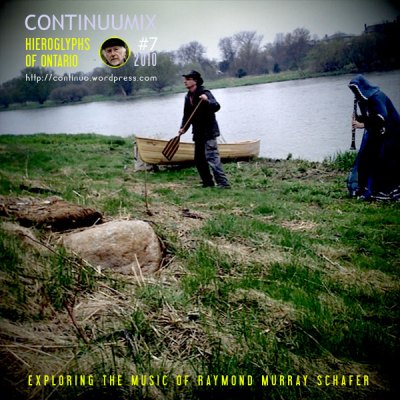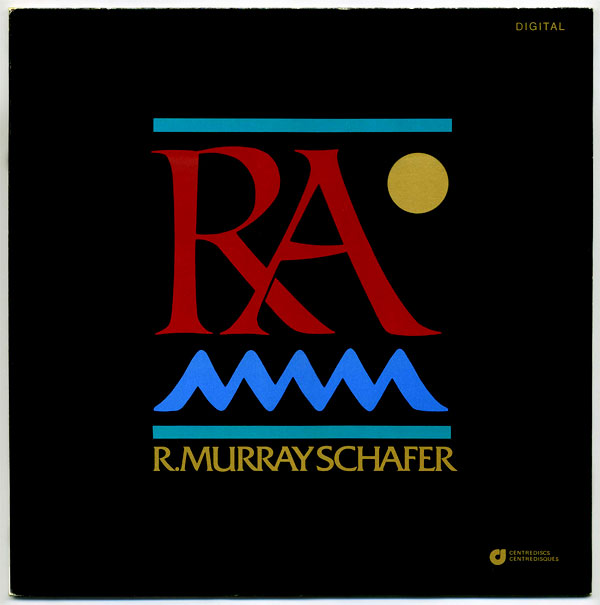Raymond Murray Schafer
Here's an excellent introduction to the works of Raymond Murray Schafer:

- Assembled by Continuo (from Ubuweb.com)
- "This mix is intended as a tribute to Raymond Murray Schafer and various pioneering aspects of his oeuvre have been included: Soundscape and Acoustic Ecology, vocal and choral music, orchestral and chamber music with echoes of Ives, Webern and Shostakovitch, outdoor music performed in the open, graphic scores and spoken word. A track by Hildegard Westerkamp, Murray Schafers close associate in the World Soundscape Project, 1973-80, is also included, as well as sound poetry by his friend bp Nichol, whose death inspired the String Quartet n°4 in 1989.

- Also highly recommended:

R. Murray Schafer - RA (1983)
(Also posted @ the Ubuweb Goodies thread.)

- Assembled by Continuo (from Ubuweb.com)
- "This mix is intended as a tribute to Raymond Murray Schafer and various pioneering aspects of his oeuvre have been included: Soundscape and Acoustic Ecology, vocal and choral music, orchestral and chamber music with echoes of Ives, Webern and Shostakovitch, outdoor music performed in the open, graphic scores and spoken word. A track by Hildegard Westerkamp, Murray Schafers close associate in the World Soundscape Project, 1973-80, is also included, as well as sound poetry by his friend bp Nichol, whose death inspired the String Quartet n°4 in 1989.

Born in Sarnia, Ontario, he studied at the Royal Schools of Music in London, the Royal Conservatory of Music, and the University of Toronto. At the latter institution he was a pupil of Richard Johnston.
His music education theories are followed around the world. He started soundscape studies at Simon Fraser University in the 1960s.
In addition to introducing the concept of soundscape, he also coined the term schizophonia in 1969, the splitting of a sound from its source or the condition caused by this split: "We have split the sound from the maker of the sound. Sounds have been torn from their natural sockets and given an amplified and independent existence. Vocal sound, for instance, is no longer tied to a hole in the head but is free to issue from anywhere in the landscape."[3] Steven Feld, borrowing a term from Gregory Bateson, calls the recombination and recontextualization of sounds split from their sources schismogenesis.[4]
In 1987 he was awarded the first Glenn Gould Prize in recognition of his contributions. In 2005 he was awarded the Walter Carsen Prize, by the Canada Council for the Arts, one of the top honours for lifetime achievement by a Canadian artist.[5] In 2009, he received the Governor General's Performing Arts Award for Lifetime Artistic Achievement.[6]
Schafer is particularly famous for his situational opera The Princess of the Stars.
> Wikipedia.
- Also highly recommended:

R. Murray Schafer - RA (1983)
(Also posted @ the Ubuweb Goodies thread.)

Comments
R. Murray Schafer: Flute Concerto / Harp Concerto / The Darkly Splendid Earth - (CBC 2000)
Threads like this are very helpful to me. Thank you for doing this. It's very cool.
The Continuumix #7 is excellent for trying this, I'd say. It's just so brilliantly assembled.
Craig
Listening Club - Classical
The Schafer Ensemble:
Theodore Gentry - Countertenor
Wendy Humphreys - Soprano
Beverley Johnston - Percussion
Stuart Laughton - Trumpet
- R. Murray Schafer Thoughts on Patria:
"It was in 1965 that I began to conceive a series of thematically unified Works under the generic title of Patria (Homeland). My idea was that two characters, a man and a woman, would engage in a search for one another through a labyrinth of different cultures and social twisting almost as if they represented the split halves of the same being. They might return in various guises with different names but the quest for unity and the homeland they were seeking would always be the same. The cross-references and relationships between individual pieces exist at many levels, which is why the metaphor for the whole series has been the labyrinth, in which Wolf (Theseus) provides the force and Ariadne the thread leading to eventual solution. The principal personages of Patria are archetypes, symbols of the psyche, drawn from both the light and dark side of our nature and presented (as in mythology) in order that we might know ourselves better.
In these works theatre meets ritual, mythology penetrates art, the activities of performer and audience become blurred, the arts court one another, flow together in confluence, even moving into areas not normally considered art forms: touch... fragrance...
Music is at the centre of all the Patria works, but none is truly operatic. Each of the Patria pieces has been shaped by its inner exigency and frequently without regard to how it might be produced. Many of the pieces require their own setting or environment. There is a certain evolution of consciousness throughout Patria, but the individual works do not have to be experienced sequentially to be understood. Each work is self-contained, but gains in richness by the over layering of themes from the others. Many of the same characters reappear and sometimes whole scenes are replayed or reworked in other pieces."
- Much more @ Opening Day Entertainment.
From the CD booklet @ Atma Classique:
- "Murray Schafers quartets have featured prominently in the repertoire of the Molinari Quartet since
its establishment in 1997. At that time, Murray Schafer had composed six string quartets.
Now, thanks in part to commissions fromthe Molinari Quartet, to its performances, and to its steady efforts
to spread these works, his oeuvre comprises 12 string quartets. The Molinari has premiered four of the six new
quartets that Shafer has composed during the past 15 years.
We, the members of the Molinari Quartet, would like to express our profound gratitude to the patrons
who have sponsored these premieres. In particular, we thank Phyllis Lambert, who made it possible for us
to celebrate our 15th anniversary in 2012 by commissioning Schafers 12th string quartet.
When I first met Murray, in 1988, I was a member of the Morency Quartet, and we were in Peterborough,
Ontario, to play a protean work of his entitled The Greatest Show. I can never forget the festive spirit of
those workdays, preparing for this open-air concert/spectacle/opera. At that time already, Murray
talked to me about his quartets as if they were his children: They all share the family look, but each is a
quite distinct entity. Is this not the hallmark of a great composer?
On numerous occasions the Molinari Quartet has played several quartets by Schafer in the same
concert, sometimes even performing a marathon of the first seven quartets in a single evening. Played
this way, as if each individual quartet was actually a single movement of a very long megaquartet, the
cyclic form of the overall work becomes eloquently clear.
With this new disc of quartets 8 through 12 the listener can also experience this cyclic form, formany relationships,
both inmaterial and in expression, link these works. Each, nonetheless, is unique and stands alone
and these quartets can be appreciated one at a time; there is no need to listen to themas an ensemble.
As performers, we are filled with emotion when playing the Schafer quartets. Sensitive and refined
writing; pure, beautiful sonorities; powerful harmonies; pungently expressive dissonances; impetuous,
energetic rhythms; fascinating transitions between episodes these are just some of the elements that
characterize Murray Schafers quartets. For us, these are great works, destined to remain in the string
quartet repertoire for many years to come."
http://quatuormolinari.qc.ca/en/
Commissioned by the French Television Network of CBC at Montreal for the programme "l'Heure du Concert", during the 1965-66 season.
Text in English by the composer (French translation by Gabriel Charpentier).
Opera for T.V.
For soprano, 3 mezzo-sopranos, 3 spoken roles, 2 violins, viola, cello, contrabass, harp, piano(harpsichord, celesta), guitar (Spanish, electric, banjo), mandolin, 6 percussion, electronic and pre-recorded sounds on tape.
- Centrediscs
R. Murray Schafer - The Crown of Ariadne
- Centredisques, November 11, 2016
Judy Loman